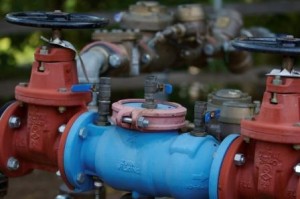Glenn Barnes is senior project director with the Environmental Finance Center based at the University of North Carolina at Chapel Hill. He is the co-director of the Smart Management for Small Water Systems Project.
Drinking water systems of all sizes can benefit from partnering with other water systems in many ways. Small drinking water systems in particular are most able to benefit from partnerships because of the issues they face with economies of scale, access to capital, and use of trained operators.
Physical interconnections between systems—pipes that bring water regularly, periodically, or during emergencies from one water system to another—are perhaps what most people think about when they hear “water system partnerships.” Systems interested in physical interconnections should ensure that the contract governing the interconnection is comprehensive, and many small drinking water systems have used physical interconnections to help bring down their cost of service.
Over the course of the past year, the EFC has met many of these systems at the finance and management workshops we have held as part of the Smart Management for Small Water Systems project. One session attendee, for example, was the mayor of a small town in North Dakota with about 40 homes and businesses. Up until just a few years ago, the town operated its own treatment plant for its 100 residents. When that treatment plant needed major capital improvements, the town found it far cheaper to connect with a neighboring community and pipe in treated water instead. We’ve also met small systems that had excess water capacity and improved their financial position by selling water to other small systems, including a small town in central Illinois that is working with us now on an inter-local agreement with a smaller neighboring town, and condos and hotels in U.S. territories that sell treated water to neighbors.
Not all small water systems, though, can easily find neighboring systems to connect to. Geography is a big concern—not just how far away the closest system with excess water capacity is, but also what obstacles (rivers, highways, mountains) may lie in between. Systems may find regulatory issues if the water they are purchasing does not blend well with the water they are still treating. Often, small water systems, in particular those operated by mobile home parks, may have old or outdated pipes that cannot handle the water pressure from larger water systems. And the small system wishing to purchase water is also likely to be responsible for paying for the pipes in between the two systems, which could run millions of dollars.
These hurdles may be enough to keep many small systems from forming partnerships. We held a workshop in Ohio last year for water systems operated by mobile home parks. Almost every system in attendance expressed interest in getting out of the water business—water service, after all, is not their primary business. But some of the mobile home parks could not afford to connect to neighboring systems because those systems were too far away, making the cost of the connection prohibitive. Still others had old pipe in the ground that would also need to be replaced. And all expressed concerns about whether their largely low-income renters could afford higher water bills, fearing that either they would lose tenants or that the tenant would not pay the bill, leaving the mobile home park operator as landowner financially liable.
And for any water systems to work together, there needs to be a certain level of trust. One workshop participant from New York, a contract engineer, shared the story of two communities that would not tie their water systems together due to distrust that arose from a brawl at a high school basketball game 40 years ago. Even the small town in North Dakota that successfully tied to a neighboring system has concerns about the frequency of rate increases demanded from their new water seller.
Thankfully, small water systems have other partnership opportunities that can help overcome some of these barriers. For example, one of the mobile home park systems in Ohio purchased water in bulk from a neighboring system but used her existing pipe network to deliver it to her tenants, eliminating the need to upgrade the pipes and meters within her complex. Some water systems have managed to achieve economies of scale by partnering together on the purchase of treatment chemicals. And others have achieved economies of scale by purchasing large numbers of water systems that are not physically interconnected but operating them as a single entity.
Regardless of the method, all water systems large and small should at least explore these many partnership opportunities in order to achieve financial savings.
To read more about partnerships for water systems, check out these related posts:
- Tools for Multi-Jurisdictional Approaches to Water Quality
- Granville Stormwater Partnership
- Water System Partnerships, Interconnections and Interlocal Agreements Web Page
Drinking #water systems of all sizes can benefit from partnering with other water systems http://t.co/XdBxNmfdtP
— Envr. Finance Center (@EFCatUNC) January 16, 2014


